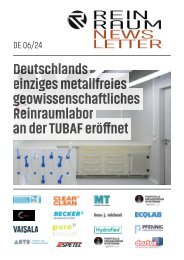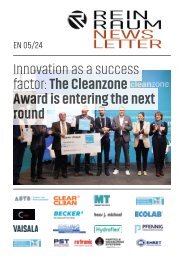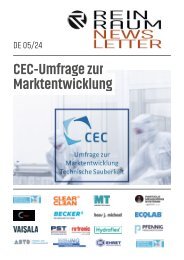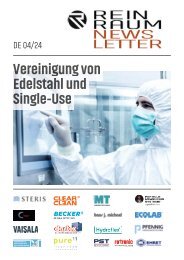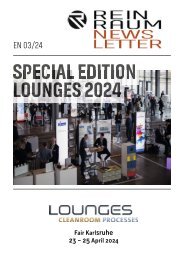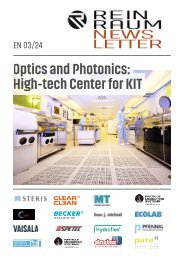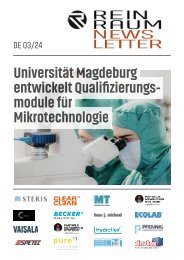Newsletter_12-2022_EN
Fachbeiträge, redaktionelle Beiträge und Veranstaltungen In einer sich schnell entwickelnden Branche sind aktuelle Informationen wichtig. reinraum online bietet einerseits Interessierten die Möglichkeit, sich aktuell und umfassend über die Reinraum-Branche zu informieren. Andererseits können Unternehmen und Personen die Plattform nutzen, Fachbeiträge, redaktionelle Artikel und Firmennews zu veröffentlichen. Ein Veranstaltungskalender ergänzt das Informationsangebot. Der ExpertenPool hilft bei der Profi-Suche: WER macht WAS im Reinraum.
Fachbeiträge, redaktionelle Beiträge und Veranstaltungen
In einer sich schnell entwickelnden Branche sind aktuelle Informationen wichtig. reinraum online bietet einerseits Interessierten die Möglichkeit, sich aktuell und umfassend über die Reinraum-Branche zu informieren. Andererseits können Unternehmen und Personen die Plattform nutzen, Fachbeiträge, redaktionelle Artikel und Firmennews zu veröffentlichen. Ein Veranstaltungskalender ergänzt das Informationsangebot.
Der ExpertenPool hilft bei der Profi-Suche: WER macht WAS im Reinraum.
You also want an ePaper? Increase the reach of your titles
YUMPU automatically turns print PDFs into web optimized ePapers that Google loves.
www.reinraum.de<br />
NEWSLETTER<br />
www.cleanroom-online.com Edition <strong>EN</strong> <strong>12</strong>-<strong>2022</strong> | Page 16/42<br />
Optimising wind energy sustainably<br />
weisstechnik supplies high-performance climate simulation systems for load tests<br />
on wind turbine electronics<br />
Wind power makes an important contribution to combating climate change. However, breakdowns as well as maintenance and repair<br />
of wind turbines are usually time-consuming and costly. This often affects the power electronics, which are exposed to extremely high<br />
loads. This is why the University of Bremen is researching how to extend their service life and optimise maintenance as part of the joint<br />
project HiPE-WiND, funded by the BMWi. As part of this project, weisstechnik has planned and implemented a climatic test chamber for<br />
multidimensional load tests.<br />
Partner for wind energy research<br />
The joint project HiPE-WiND (High Power Electronics in Wind Energy<br />
Plants) is being led by the Institute for Electrical Drives, Power Electronics<br />
and Devices at the University of Bremen in cooperation with the<br />
Fraunhofer Institute for Wind Energy Systems in Bremerhaven. In order<br />
to find out which components of the power electronics fail under<br />
which conditions, long-term load tests are carried out on complete<br />
wind turbine converter systems up to the ten megawatt class. This<br />
simulates the high loads caused by changing wind conditions and<br />
the power grid under different climatic conditions - from the Arctic to<br />
the Sahara. All this is taking place in the customised climate chamber<br />
developed by weisstechnik. As the climatological heart of the „HiPE-<br />
LAB“ in Bremen, the climate chmber helps to realistically and quickly<br />
recreate how the converter systems age under the multimodal loads<br />
during 20 years of use.<br />
300 kW large-scale facility with heavy duty floor<br />
As an experienced specialist in environmental technology, weisstechnik<br />
was able to successfully win the tender for the facility and<br />
plan and realise the project from a single source. The size and performance<br />
of the walk-in and drive-in chamber was a demanding task<br />
in itself, needing a usable test space volume of approx. 190 m3 and<br />
an electrical connected load of just under 300 kW. The surface load<br />
of the heavy-duty floor in the test space is more than 10,000 N/m2.<br />
The large test specimens - switch cabinets with converters - weighing<br />
up to 5,000 kg are moved into the test chamber on rollers via<br />
a double-wing door. The inner chamber walls are made of stainless<br />
steel (welded vapour-tight) and have a 200 mm thick 2-layer insulation<br />
consisting of special foam and mineral wool. A side door serves<br />
as access for the staff.<br />
Environmentally friendly CO2 refrigeration system<br />
The required temperature range for the tests is (-)40 °C to (+)<strong>12</strong>0 °C. In<br />
order to realise this as efficiently and environmentally friendly as possible,<br />
a CO2 cascade refrigeration system was used. This means that<br />
temperatures down to (-)45 °C can be achieved with ease while at<br />
the same time enabling a high level of thermal compensation. This is<br />
important for the load tests because the test specimens tested under<br />
load generate a high thermal load. This is around 70 kW at 100 °C and<br />
a humidity range of up to 95% RH and 50 kW at 85 °C/85% RH. The<br />
use of CO2 as a refrigerant necessitates additional safety devices. It<br />
was therefore necessary to integrate a standstill cooling system with<br />
a separate power supply in order to prevent the CO2 from expanding<br />
and to avoid excessive system pressure during system standstill. In addition,<br />
a gas warning system is integrated in the test chamber and<br />
in the equipment compartment, which triggers visual and acoustic<br />
alarms and activates the emergency purge if CO2 escapes. Furthermore,<br />
the oxygen content is continuously monitored with redundant<br />
measuring technology.<br />
(Source: Weiss Technik GmbH)









